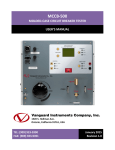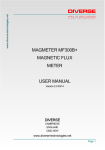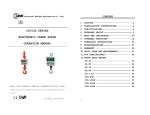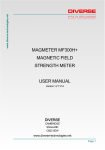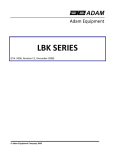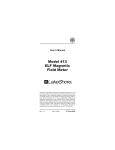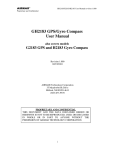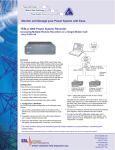Download Manual - ETS
Transcript
Model 6400 Series Helmholtz Coil User Manual ETS-Lindgren L.P. reserves the right to make changes to any product described herein in order to improve function, design, or for any other reason. Nothing contained herein shall constitute ETS-Lindgren L.P. assuming any liability whatsoever arising out of the application or use of any product or circuit described herein. ETS-Lindgren L.P. does not convey any license under its patent rights or the rights of others. © Copyright 2001–2011 by ETS-Lindgren L.P. All Rights Reserved. No part of this document may be copied by any means without written permission from ETS-Lindgren L.P. Trademarks used in this document: The ETS-Lindgren logo is a trademark of ETS-Lindgren L.P. Revision Record | 6400 Series Helmholtz, MANUAL | Part #399273, Rev. B Revision Description Date A Initial Release December, 2001 B Updated title to reflect series. June, 2009 Revise to current style standards. Removed filter addendum, add filter information as a numbered section C Update table format in Section 3, Specifications. Update measurement in Section 5, Operation from 2.45 cm to 2.54 cm ii | April, 2011 Table of Contents Notes, Cautions, and Warnings ............................................... iv 1.0 Introduction .......................................................................... 5 Model 6406S or Split Base Helmholtz Coils .................................................. 6 ETS-Lindgren Product Information Bulletin ................................................... 6 2.0 Maintenance ......................................................................... 7 Maintenance Recommendations ................................................................... 7 Annual Calibration ......................................................................................... 7 Service Procedures ....................................................................................... 7 3.0 Specifications....................................................................... 9 4.0 Theory of Operation........................................................... 13 5.0 Operation ............................................................................ 17 Helmholtz Coil Placement ............................................................................ 17 Helmholtz Coil EUT Table ........................................................................... 17 Adding Power to the Helmholtz Coil ............................................................ 18 Appendix A: Warranty ............................................................. 21 Appendix B: Conversion Table for Magnetic Units .............. 23 | iii Notes, Cautions, and Warnings Note: Denotes helpful information intended to provide tips for better use of the product. Caution: Denotes a hazard. Failure to follow instructions could result in minor personal injury and/or property damage. Included text gives proper procedures. Warning: Denotes a hazard. Failure to follow instructions could result in SEVERE personal injury and/or property damage. Included text gives proper procedures. See the ETS-Lindgren Product Information Bulletin for safety, regulatory, and other product marking information. iv | 1.0 Introduction ETS-Lindgren Model 6400 Helmholtz Coils create an extremely uniform low frequency magnetic field between and in the center of the coils. The generated field can be applied as a magnetic field immunity test system or a low frequency calibrator. The strength of the magnetic field generated is directly proportional to the number of turns in the coils and the current applied to them. The coils are wound in series so that the magnetic field produced by current flowing in one coil aids the field in the other coil. The windings on all standard Helmholtz coils are wound of insulated magnet wires. The wire gauge varies depending upon the model of the coil system and details are found in the Specification section of this manual. The maximum current of a custom Helmholtz coil is determined by the wire gauge. Several of the Helmholtz coils are equipped with a rotatable, adjustable-height pedestal capable of supporting equipment under test (EUT) in the center of the assembly base. Equipment which is exposed to the homogenous magnetic field should be placed on the equipment test table with the height adjusted so that the center of the equipment is closely aligned with the axis of the coils. Ferromagnetic objects within the cylindrical volume of the coil tend to distort the magnetic fields in areas near the object. The coil system has been constructed with minimal metallic components limited to the copper conductors, the electrical connectors and the caster frames. The casters, however, are outside of the coil cylinder and cause practically no field disturbance. Precision in the manufacture of the coils and their support assembly are well within a design tolerance of 0.5 cm (0.2 in) in both radius and axial separation. The limit of this tolerance would produce a maximum error of 0.55% in the accuracy of the magnetic field constant under the worst conditions. For this reason the Helmholtz coil is considered a standard and produces a magnetic field whose accuracy is governed by the accuracy of the current monitoring equipment. Introduction | 5 Model 6406S or Split Base Helmholtz Coils A standard ETS-Lindgren Helmholtz coil consists of two identical circular coils placed in parallel and spaced one radius apart. The coils are both mounted to a single base with an adjustable pedestal placed in the center to position the EUT. Some EUT’s, however, do not fit conveniently on the pedestal. In these instances a split base option may be ordered. Each coil is mounted on a separate wheeled base for positioning on either side of the EUT, such as an automobile. The Model 6406S Helmholtz Coil consists of two coils secured on separate base mounts in the Helmholtz configuration which can be used as a low frequency calibrator. The coil provides a magnetic field which is essentially homogenous throughout the volume of a 0.60 meter (2 foot) cylinder in its center. The coil forms are rigidly supported by a nonmetallic, nonmagnetic framework. The supplied cable assembly and proper orientation of the coils insures that the Helmholtz coil system is arranged in the series-aiding configuration. ETS-Lindgren Product Information Bulletin See the ETS-Lindgren Product Information Bulletin included with your shipment for the following: 6 • Warranty information • Safety, regulatory, and other product marking information • Steps to receive your shipment • Steps to return a component for service • ETS-Lindgren calibration service • ETS-Lindgren contact information | Introduction 2.0 Maintenance Before performing any maintenance, follow the safety information in the ETS-Lindgren Product Information Bulletin included with your shipment. Maintenance of the Helmholtz coil is limited to external components such as cables or connectors. Clean the exterior of the coil using a damp WARRANTY cloth and mild cleaner. Always unplug the unit before cleaning. If you have any questions concerning maintenance, contact ETS-Lindgren Customer Service. Maintenance Recommendations Maintenance is limited to periodically cleaning the coil with a clean, damp cloth. Annual Calibration See the Product Information Bulletin included with your shipment for information on ETS-Lindgren calibration services. Service Procedures For the steps to return a system or system component to ETS-Lindgren for service, see the Product Information Bulletin included with your shipment. Maintenance | 7 This page intentionally left blank. 8 | Maintenance 3.0 Specifications Currents higher than the “Maximum Current Input” listed may be used if the appropriate duty cycles are applied See table in Appendix B for conversion to Gauss/Ampere Model 6402 Model 6402M Type Mono-axial Mono-axial Coil Radius 30.5cm 30.5cm (12.0 in) (12.0 in) Turns Per Coil 36 5 Gauge (AWG) 10 20 Coil Factor (Amperes/Meter/Ampere) 84.3 11.14 1.06 0.14 R (Ohms DC) 0.5 0.7 L (mH) 3.5 70 Max Continuous Field 21.2 1.5 20 10 32 500 Coil Factor (Gauss/Amperes) (Gauss) Max. Current Input (Amperes Continuous) Self Resonance (kHz) Homogeneity Mating Connector ±10% within a ±10% within a 19.8cm cylinder 25.4cm cylinder MS3106, A-20- BNC 09S Specifications | 9 Model 6403 Model 6404 Type Mono-axial Mono-axial Coil Radius 45.7cm 60.9cm (17.9 in) (23.9 in) Turns Per Coil 25 56 Gauge (AWG) 10 10 Coil Factor 39.79 65.25 0.50 0.83 R (Ohms DC) 2.5 1.5 L (mH) 40 19 Max Continuous Field 10 16.5 20 20 40 40 (Amperes/Meter/Ampere) Coil Factor (Gauss/Amperes) (Gauss) Max. Current Input (Amperes Continuous) Self Resonance (kHz) Homogeneity Mating Connector 10 | ±10% within a ±10% within a 23cm cylinder 40cm cylinder MS3106, A-20- MS3106, A-20- 23S 09S Specifications Model 6406 Model 6406S Model 6408 Type Mono-axial Mono-axial Mono-axial Coil Radius 91.4cm 91.4cm 115.0cm Turns Per Coil 64 110 64 Gauge (AWG) 10 6 10 86.04 39.79 0.63 1.08 0.50 R (Ohms DC) 2.5 1.7 3.0 L (mH) 45 100 64 Max Continuous Field 12.6 43.2 10 20 40 20 43 4 >10 Coil Factor (Amperes/Meter/Ampere) Coil Factor 50.06 (Gauss/Amperes) (Gauss) Max. Current Input (Amperes Continuous) Self Resonance (kHz) Homogeneity Mating Connector ±10% within a ±10% within a ±10% within a 0.6m cylinder 0.6m cylinder 0.7m cylinder MS3106, A-24- MS3106, A-24- MS3106, A-24-09S 09S 09S Specifications | 11 This page intentionally left blank. 12 | Specifications 4.0 Theory of Operation Before operating any components, follow the safety information in the ETS-Lindgren Product Information Bulletin included with your shipment. The basic premise of a Helmholtz coil is that it produces a homogeneous magnetic field in its center which is directly proportional to the number of turns in the coils and the current applied to them. A Helmholtz coil is a parallel pair of identical circular coils spaced one radius apart and wound so that the current flows through both coils in the same direction. The winding results in a very uniform magnetic field between the coils with the primary component parallel to the axes of the two coils. The uniform field is the result of the addition of the two field components parallel to the axes of the two coils and the difference between the components perpendicular to the axes. The primary purpose of this device is to provide a uniform, low frequency magnetic field for susceptibility testing of electronic equipment. The magnetic field strength (H) produced by a given AC or DC current through the coil pair is given approximately by the formula H ≈ 0.899 NI R • H is the magnetic field in oersteds • N is the number of turns per coil • I is the coil current in amperes • R is the coil radius in centimeters Theory of Operation | 13 In SI Units, this becomes the formula where H ≈ 0.715 NI R • H is the magnetic field in amperes per meter • N is the number of turns per coil • I is the coil current in amperes • R is the coil radius in meters If instead of magnetic field intensity (H) the magnetic flux density (B) is the parameter of interest the equation, when expressed in CSG units, becomes B = μH ≈ 0.899 μ NI R • B is the magnetic flux density in gauss • µ is the relative permeability • N is the number of turns per coil • I is the coil current in amperes • R is the coil radius in centimeters 14 | Theory of Operation In SI units, the relationship is given by B = μμ 0 H ≈ 8.99 × 10 −7 μ NI R • B is the magnetic flux density in teslas • µ is the relative permeability • µο is the permeability constant • N is the number of turns per coil • I is the coil current in amperes • R is the coil radius in meters For the unloaded coil, the relative permeability, µ, is one, so that units, and B = μ0 H in SI units. B=H in CGS Refer to Appendix B: Conversion Table for Magnetic Units for more unit conversions. Theory of Operation | 15 This page intentionally left blank. 16 | Theory of Operation 5.0 Operation Before operating any components, follow the safety information in the ETS-Lindgren Product Information Bulletin included with your shipment. If high driving current is required at a high frequency, take precautions to avoid shock or burn from the high voltages developed across the reactive elements. Helmholtz Coil Placement Place the Helmholtz coil in a space relatively free of metal objects and structures. This will insure a minimum of distortion and the best possible homogeneity of magnetic fields within the test volume. Push the coil assemblies into position by holding the coil section of each assembly. Do not push the coil assemblies using the thermoplastic support rods. Helmholtz Coil EUT Table For units equipped with an adjustable table, the table should be set at the desired height before placing the test item on it. To adjust the table height, first loosen the clamp screw(s) and then move the table height up or down to the desired level. Hand-tighten the clamp screw(s). The table can be lifted off of the platform to accommodate larger EUTs. Simply remove the plastic support screws on the floor of the coil platform that attach the table and gently lift and remove the table. The marks on the support column are spaced 2.54 cm(1 inch) apart for reference. A mechanical stop limits the table travel within its lowest and highest position. The top of the table is within 2.54 cm (1 inch) of the coil system axis when the lowermost inch mark is at the top of the base column. Operation | 17 Limit the weight of the equipment placed on the table to the coil specifications in the chart that follows. Center the EUTs mass over the center of the base. Do not lubricate the support column, but keep the column clean by periodically cleaning with a clean, damp cloth. Model Weight Limit 6402 18 kg (40lb) 6402M 4.5 kg (10lb) 6403 18 kg (40 lb) 6404 34 kg (75 lb) 6406 34 kg (75 lb) 6406S Split base, no table 6408 34 kg (75 lb) With the exception of the wire, connectors and casters (if equipped) the entire coil structure is made of non-conductive, non-magnetic materials. Handle the structure carefully at all times, taking precautions to avoid subjecting it to thermal or mechanical shock. Adding Power to the Helmholtz Coil When connecting the AC or DC current source for driving the Helmholtz coil magnetic field generator coil, be sure the connecting leads are of sufficiently heavy gauge to handle the required current. For example, AWG 10 wire is required for 20 amperes, based on a rule of thumb of 500 circular mils per ampere. Also be certain that there is good mechanical bonding between connecting leads to both the current source and the Helmholtz coil input connector. The coils are wound with #10 AWG copper wire so that they may be driven with 20 amperes continuously for generating magnetic fields up to 10 gauss. Lower intensity fields may be generated by using a calibrated current supply or by monitoring the voltage across a series resistor. The Models 6402M, 6406S and certain custom coils are not wound with #10 AWG, therefore power should be applied to correlate with the wire gauge. 18 | Operation Magnetic fields greater than one gauss may be generated at frequencies from DC to 200 Hz. However, if higher frequencies are required, the coil impedance will require fairly high driving voltages to drive enough current through the coil in order to reach the desired field intensity. In certain cases, it may be necessary to series resonate the coil if high driving current is required at a high frequency. If this is the case, take precautions to avoid shock or burn from the high voltages developed across the reactive elements. Operation | 19 This page intentionally left blank. 20 | Operation Appendix A: Warranty See the Product Information Bulletin included with your shipment for the complete ETS-Lindgren warranty for your Helmholtz Coil System. DURATION OF WARRANTIES FOR A HELMHOLTZ COIL SYSTEM All product warranties, except the warranty of title, and all remedies for warranty failures are limited to two years. Product Warranted Duration of Warranty Period Helmholtz Coil System 2 Years Warranty | 21 This page intentionally left blank. 22 | Warranty Appendix B: Conversion Table for Magnetic Units To To Convert From Unit System: Magnetic Quantity: Units SI (MKS) tesla 1 ampturn/m gauss CGS B H B H B tesla ampturn/m -7† 4π x 10 gauss oersted gamma 10 1 79.57747 7.96 x 10 5‡ 4 4π x 10 -3† 1 10 -4 10 ‡ 79.57747 1 oersted 10 4‡ 4π x 10 -3 1 ‡ gamma 10 9 4π x 10 2† 10 -4† 10 7.96 x 10 † 1 5 10 -9 5† 10 -5 10 -5‡ -4‡ 1 Multiply by above value † Assumes μ = 1; if μ ≠1, multiply by value of μ to convert from H to B. ‡ Assumes μ = 1; if μ ≠1, divide by value of μ to convert from B to H. 2 1 tesla ≡ 1 weber/m . For example, 4 1 tesla = 10 gauss. 1 gauss = 79.6 ampere-turns/m in an unloaded coil (μ = 1). 5 5 If μ = 2.50, 1 tesla = 7.96 x 10 / 2.50 = 3.18 x 10 amp-turns/m. Conversion Table for Magnetic Units | 23 This page intentionally left blank. 24 | Conversion Table for Magnetic Units

























